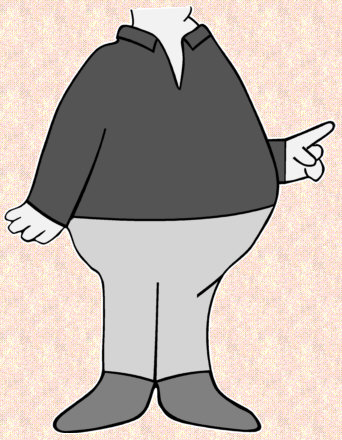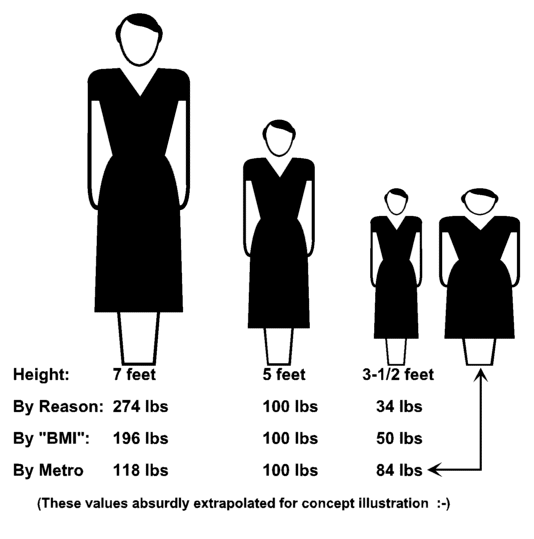 Body
Mass Index is an established buzz-phrase and
method for stating ranges of body weight, with respect to attributes like
"obesity". It's claimed that BMI tables tell you where you're supposed
to be --weight-wise.
Body
Mass Index is an established buzz-phrase and
method for stating ranges of body weight, with respect to attributes like
"obesity". It's claimed that BMI tables tell you where you're supposed
to be --weight-wise.
 Body
Mass Index is an established buzz-phrase and
method for stating ranges of body weight, with respect to attributes like
"obesity". It's claimed that BMI tables tell you where you're supposed
to be --weight-wise.
Body
Mass Index is an established buzz-phrase and
method for stating ranges of body weight, with respect to attributes like
"obesity". It's claimed that BMI tables tell you where you're supposed
to be --weight-wise.
Unfortunately, the formula for BMI is unusable by most Americans because it's stated in terms of meters and kilograms of "mass" --thus:
--while Americans think in terms of "weight", "pounds", "feet and "inches".
The BMI is getting deserved criticism. (See:
* The BMI formula states that your body mass goes up by the square of your height--! --but in the real world, the volume (and, therefore, the mass and weight) of things (with fixed proportions) goes up by the cube of height.
The volume of a sphere = 4/3 x pi x radius3
The volume of an equal-sided box = height 3
One would expect, then, that the weight of a person
is proportional to height cubed.

--But: neither is the case. Such numbers have been based on actual health outcomes --"what works" (weight-wise).
Body Mass Index (BMI) came from the U.S. government's 1998 "Clinical Guidelines on the Identification, Evaluation, and Treatment of Overweight and Obesity in Adults" --and speaking of "outcomes", the best known tables are actuarially based, having been developed by the Metropolitan Life Insurance Company in 1983. Presumably^, they identified the best height to weight ratios by association with the lowest rates of death and disease for men and women.
(^I may have presumed wrong --historically. See my update.)
But: if you work the numbers on that study, it would seem that best weight follows not even the square of one's height, but something even more anemic (for tall people): about a 1.5 power relationship! (ie: X raised to the 1.5th power)
Yes and you betcha(!) --people DO scale by the cube of their height --if they're to look proportionately the same, but a "1.5th power" relationship means that short people get to be (and apparently should be) much plumper than tall people --in order to achieve their best shot at living to be a happy, if wumpydumpish, octogenarian. (Life seems unfair to tall/big people, who are essentially told to go through life looking like a rack of bones!)
At the Wikipedia entry:
> https://en.wikipedia.org/wiki/Body_mass_index
--is an excellent treatment of BMI, where we read: "Since mass increases to the 3rd power of linear dimensions, taller individuals with exactly the same body shape and relative composition, have a larger BMI", but I think the article and its sources somewhat lose their way, failing to note that the basis was in health statistics (those Metropolitan Life height and weight tables) --regardless of whether the BMI formula makes geometric sense. (Again: see my update.)
One might try using as a rationale that we're all "handed out" essentially the same organs, tissues, and blood pressure (pumping) capacity --which increase little with "stature" and hardly at all with mass.
Perhaps, then, BMI (but with height raised to the 1.5th
power) amounts to a shorthand way to suggest good ranges of body weight.
Or: we could just caliper your fat folds (--ouch!). All such approaches
serve to make us mindful that body fat is both unappealing and unhealthy.
Should you want to relate to this BMI concept in terms of English measure (and not have to deal in small decimal values), the following is the (inverse) equivalent:
BMIe = [height(inches)]2 ÷ weight(pounds)
Suggested BMI Ranges With "BMIe" Equivalents
BMI = 16; BMIe = 44: ---Edge of severe starvation and (surely) the lower edge of "attractiveness"
BMI = 20; BMIe = 35: ---Lower edge of "mild starvation"
BMI = 24; BMIe = 29: ---Upper edge of "attractiveness" and "acceptable" body weight
BMI = 30; BMIe = 23: ---Lower edge of clinical obesity
BMI = 40; BMIe = 18: ---Simple obesity becomes "gross" or "morbid" obesity
* Personally, I think these ranges are unrealistically high hurdles. My own weight as a young man in the Navy (which looked good on my frame) placed me just under a BMIe of "29", but at this point in my life (age 75), I'd be pleased with myself just to reach "27".
* While a lot of bulk can stress your organs, crash and repeated weight-loss efforts are even worse. As I understand it, the gall-bladder aids in metabolizing fat. When you're losing weight, your main diet becomes fat (your own!), which really taxes and sometimes kills off that organ.
One's "basal metabolic rate" (BMR) --the rate at which you use up the caloric value of food while at rest, might be only 1500 calories per day (versus maybe 2500 calories/day for a normally active person of average gender :-))) --and weight). Since a pound of body fat is "worth" 3000 calories, by only dieting, doing hardly any exercise, and trying to lose (say) 1/2 pound per day, you'd be eating almost nothing and "burning" pure fat for your metabolism!
In other words: GO SLOW!Take
it off slowly.
Exercise in the morning --which gets your metabolic
"set point" up for the day (which might be an "urban legend"), such that
you're (hopefully) taking off less muscle (heart muscle?!) along with your
fat.
![]()
* There's an excellent, 7 year-old,
mostly well informed discussion
of BMI at "The Straight Dope". It turns out that the BMI concept goes
back to 1832 and one Adolphe Quetelet --a Belgian mathematician, astronomer
and statistician, who very deliberately chose squaring height against mass/weight.
Since then, raising height to the 2.5th or 2.6th power seems more reasonable,
but that still leaves short folks a bit "squat", and tall folks a bit spare.
![]()
The following was originally from
the "Best Health" library at http://www.besthealth.com/
(but
the link no longer seems to work):
"What does being 'obese' mean?"
"If your weight is substantially above what is healthy for a person with your body composition, genetic background, and overall health status (based on other risk factors you might have), you may be considered obese. Being obese means you are at increased risk for heart diseases, stroke, high blood pressure, diabetes, arthritis, cancer, and other disorders."
"Your doctor can give you a good sense of whether or not your weight puts you in the category of being obese. As a rule of thumb, you might find the weight categories shown in the following tables to be useful."
Ideal Weight for Women
-----------------------------------------------
Height
Small Medium
Large
in Shoes
Frame Frame
Frame
--------------------------------------------------------
6'
138 to 151 lb 148 to 162 lb 158 to
179 lb
5'11" 135 to 148 lb
145 to 159 lb 155 to 176 lb
5'10" 132 to 145 lb
142 to 156 lb 152 to 173 lb
5'9" 129 to 142
lb 139 to 153 lb 149 to 170 lb
5'8" 126 to 139
lb 136 to 150 lb 146 to 167 lb
5'7" 123 to 136
lb 133 to 147 lb 143 to 163 lb
5'6" 120 to 133
lb 130 to 144 lb 140 to 159 lb
5'5" 117 to 130
lb 127 to 141 lb 137 to 155 lb
5'4" 114 to 127
lb 124 to 138 lb 134 to 151 lb
5'3" 111 to 124
lb 121 to 135 lb 131 to 147 lb
5'2" 108 to 121
lb 118 to 132 lb 128 to 143 lb
5'1" 106 to 118
lb 115 to 129 lb 125 to 140 lb
5'
104 to 115 lb 113 to 126 lb 122 to
137 lb
4'11" 103 to 113 lb
111 to 123 lb 120 to 134 lb
4'10" 102 to 111 lb
109 to 121 lb 118 to 131 lb
--------------------------------------------------------
From height and weight tables of the Metropolitan
Life
Insurance Company, 1983. The ideal weights
given in these
tables are for ages 25 to 59. The weights
assume you are
wearing shoes with 1-inch heels and indoor
clothing
weighing 3 pounds.
Ideal Weight for Men
-----------------------------------------------
Height
Small Medium
Large
in Shoes
Frame Frame
Frame
--------------------------------------------------------
6'4" 162 to 176
lb 171 to 187 lb 181 to 207 lb
6'3" 158 to 172
lb 167 to 182 lb 176 to 202 lb
6'2" 155 to 168
lb 164 to 178 lb 172 to 197 lb
6'1" 152 to 164
lb 160 to 174 lb 168 to 192 lb
6'
149 to 160 lb 157 to 170 lb 164 to
188 lb
5'11" 146 to 157 lb
154 to 166 lb 161 to 184 lb
5'10" 144 to 154 lb
151 to 163 lb 158 to 180 lb
5'9" 142 to 151
lb 148 to 160 lb 155 to 176 lb
5'8" 140 to 148
lb 145 to 157 lb 152 to 172 lb
5'7" 138 to 145
lb 142 to 154 lb 149 to 168 lb
5'6" 136 to 142
lb 139 to 151 lb 146 to 164 lb
5'5" 134 to 140
lb 137 to 148 lb 144 to 160 lb
5'4" 132 to 138
lb 135 to 145 lb 142 to 156 lb
5'3" 130 to 136
lb 133 to 143 lb 140 to 153 lb
5'2" 128 to 134
lb 131 to 141 lb 138 to 150 lb
--------------------------------------------------------
From height and weight tables of the Metropolitan
Life
Insurance Company, 1983. The ideal weights
given in these
tables are for ages 25 to 59. The weights
assume you are
wearing shoes with 1-inch heels and indoor
clothing
weighing 5 pounds.
"Your frame size or body build is determined by the thickness of the bones in your elbows, knees, ankles, and wrists. The Metropolitan Life Insurance Company offers this method of determining your body frame size: Extend your arm and bend your forearm upward at a 90 degree angle. With your fingers straight, turn the inside of your wrist toward your body. Place your thumb and index finger of the other hand on the two prominent bones of the elbow. Measure the space between the fingers against a ruler or a tape measure. Compare your measurement with the figures in the table below. Elbow measurements less than those given indicate a small frame; greater measurements indicate a large frame."
Height
in
Elbow Breadth for
1-inch
Heels
Medium Frame
--------------------------------------------
Women
4'10"
to 5'3"
2 1/4" to 2 1/2"
5'4"
to 6'0"
2 3/8" to 2 5/8"
Men
5'2"
to 5'7"
2 1/2" to 2 7/8"
5'8"
to 6'3"
2 3/4" to 3 1/8"
6'4"
2 7/8" to 3 1/4"
--------------------------------------------
Metropolitan Life Insurance Company, 1983.
"It is important to consider body composition. If you are muscular and athletic, you may weigh more than a sedentary person of the same height and frame size, yet you may be trim, while your sedentary counterpart may be overweight. If your weight comes from muscle, you may fall technically into the overweight category yet not be fat. In general, however, as you approach 20% or more above your desirable weight, your excess weight usually comes from fat."
"If you are obese, you can begin a safe, healthy, well
balanced diet to lose weight. The most effective weight management program
is not a diet at all, but a gradual change in eating and physical activity
habits that you can continue for the rest of your life. "
---------End of Page---------